Let’s be honest: kids’ clothes multiply like gremlins. One minute the dresser is tidy; the next, it’s a sock-and-glitter explosion. If you’re ready to tame the chaos without spending your entire weekend folding tiny leggings, these 7 kids clothes organization strategies will make mornings smoother, laundry less soul-sucking, and closets actually cute. Grab a basket—let’s do this.
1. Create “Get-Ready” Zones That Do the Thinking for You
Kids love independence (until it’s time to find shoes). Set up a simple, low-to-the-ground system so they can grab outfits without yelling your name 47 times.
How to Set It Up
- Use low drawers or cubbies for everyday items: tops, bottoms, underwear, socks. Keep fancy or seasonal stuff higher up.
- Label everything with words + pictures. FYI: a sock icon on a bin slices your morning search time in half.
- Outfit bins for the week: Five small bins labeled Mon–Fri. Pre-load outfits (yes, including socks). Your future self will high-five you.
Bonus: Add a small mirror and a hook for tomorrow’s outfit. Zero debate, zero drama.
2. Sort by Size, Not Just Type—Because Growth Spurts Are Sneaky
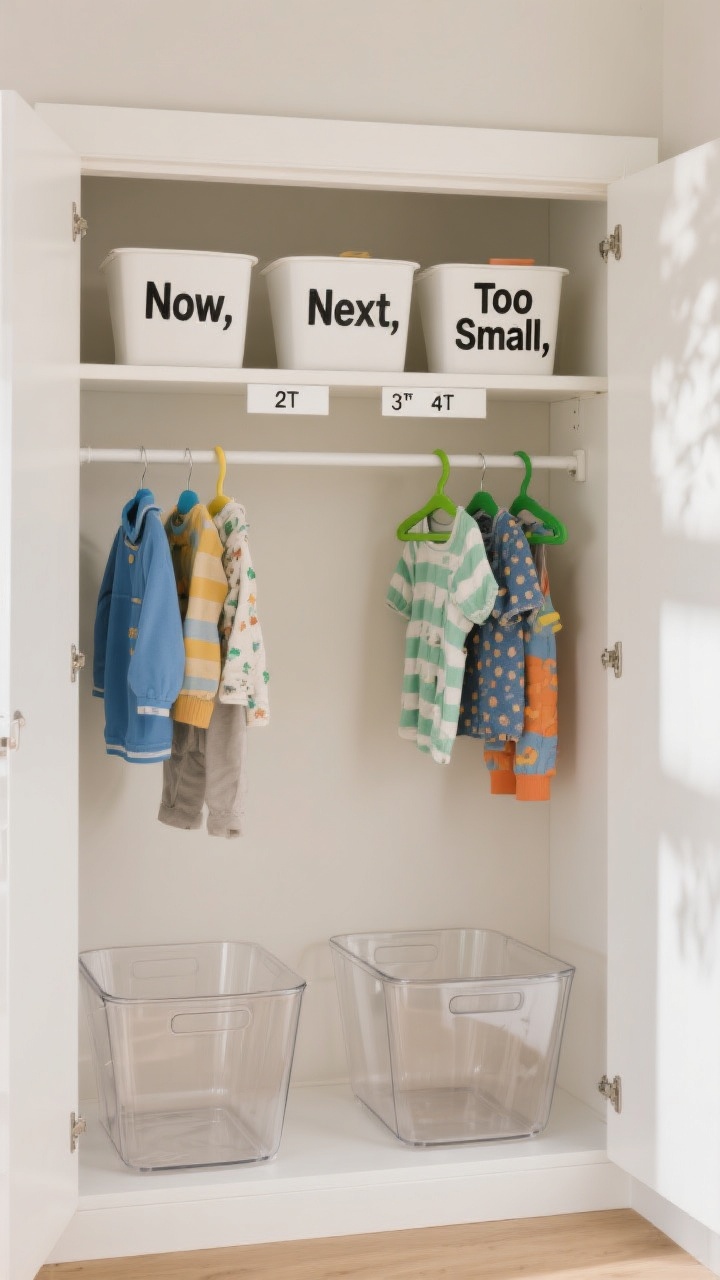
One minute a T-shirt fits; the next it’s a crop top. Sorting by size helps you rotate clothes without digging through a mountain of “almost fits.”
Smart Sizing Strategy
- Keep “Now,” “Next,” and “Too Small” bins on a shelf. Move items along the chain as needed. Easy.
- Use divider labels in the closet: 2T, 3T, 4T, etc. If you’ve got two kids sharing, color-code hangers per kid.
- Quarterly purge: Set a calendar reminder. Donate or store outgrown pieces fast to keep drawers from bloating.
IMO, the “Next” bin is the single greatest hack for hand-me-downs. It saves money and your sanity.
3. Fold Less, File More—And Ditch Perfection
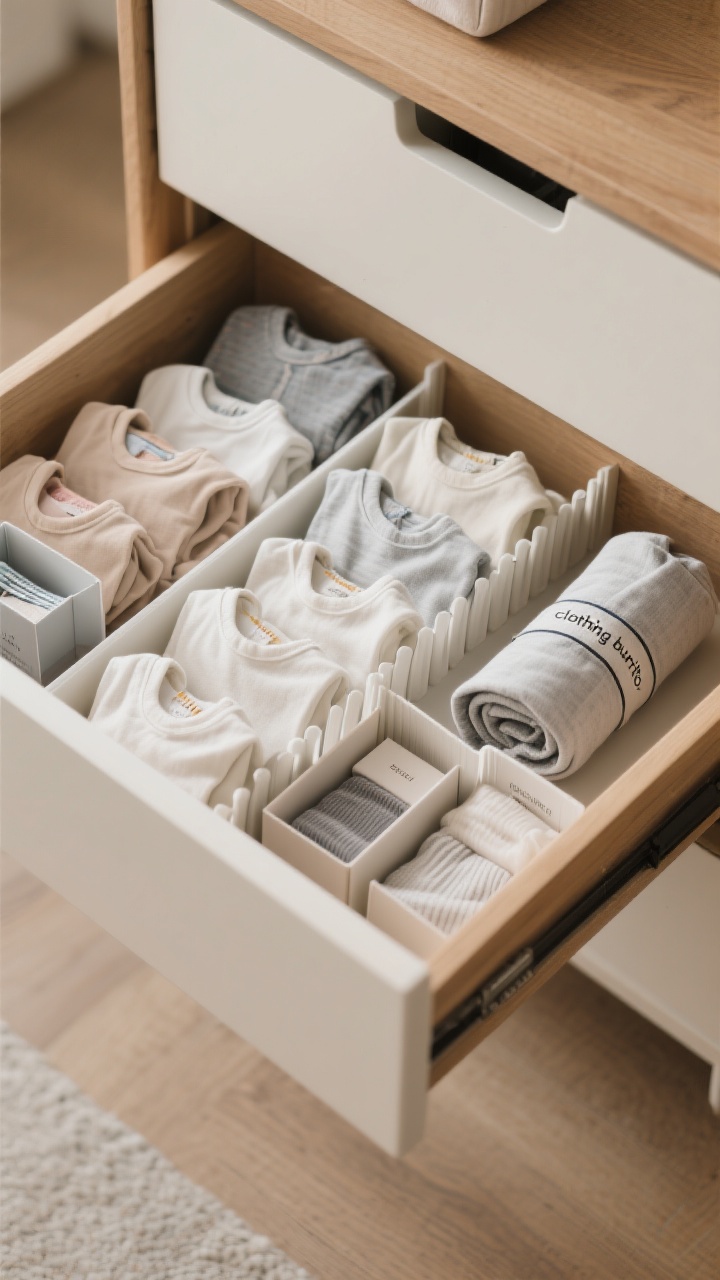
If folding tiny shirts makes you question your life choices, same. File-folding is faster, tidier, and actually stays that way when kids rummage.
File-Folding Basics
- File, don’t stack: Fold shirts and leggings into rectangles and stand them upright in drawers. You can see everything at a glance.
- Use drawer dividers or small boxes to keep categories contained (underwear, socks, pajamas).
- Roll pajamas and tuck the top into the pants waistband—little clothing burritos that don’t unravel in the drawer.
Remember: good enough beats museum-level perfect. Your drawers are not an Instagram grid; they’re a survival system.
4. Go Vertical: Hooks, Rods, and Racks to the Rescue
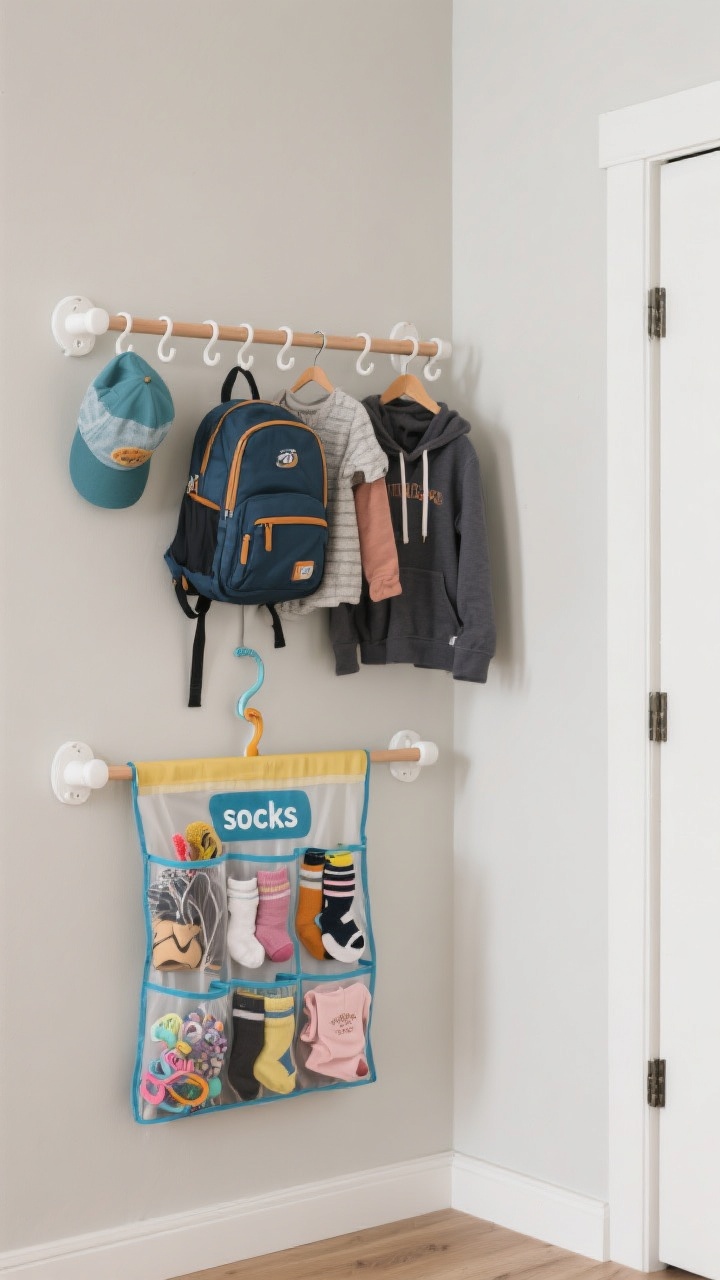
When floor space is precious, walls are prime real estate. Vertical storage keeps daily-use items easy to grab and even easier to put away.
Space-Savvy Moves
- Install double closet rods to hang tops on the upper bar and bottoms on the lower. Short kids can actually reach!
- Use command hooks for hats, backpacks, hoodies, and tomorrow’s outfit. Instant tidiness.
- Over-the-door organizers: Think beyond shoes. Use them for socks, tights, hair accessories, and tiny tees.
Pro tip: Hang a mesh laundry bag on a hook for socks. When full, toss the whole bag in the wash. Sock orphans, begone.
5. Seasonal Swaps and Capsule Wardrobes (Yes, Even for Kids)

Fewer choices = faster mornings. Build mini “capsules” that mix and match, then rotate by season so drawers aren’t bursting with snow pants in July.
Build a Kid Capsule
- Pick a color palette (neutrals + 2 accent colors). Everything goes together, so your kid can’t pick a clashing disaster… probably.
- Set quantity caps: e.g., 8 tees, 6 leggings/shorts, 7 underwear, 7 socks, 3 pajamas, 2 sweaters. Adjust for laundry frequency.
- Use vacuum bags or clear bins for off-season storage. Label clearly: “Winter 6–7Y.” Future you will cry happy tears.
When seasons change, do a 20-minute switch: move off-season out, “Next” bin in. Easy-peasy.
6. Make Laundry Kid-Proof (And Actually Come Back Together)
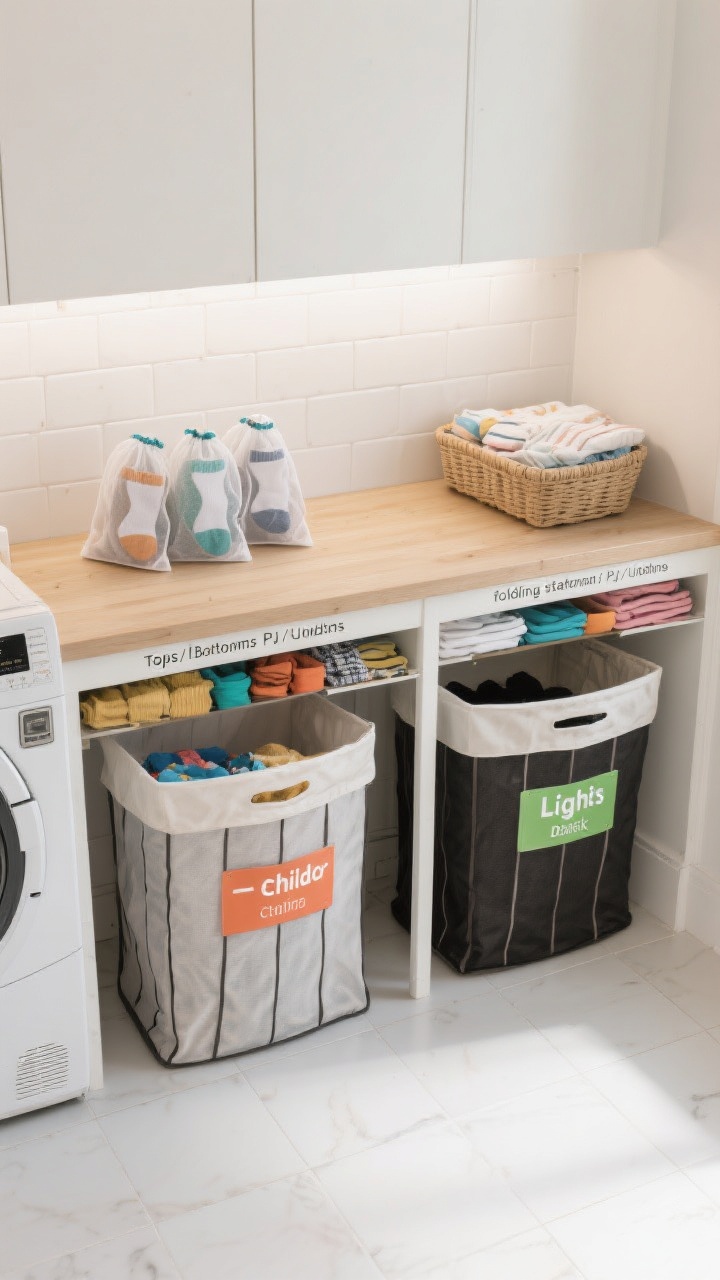
Laundry is where organization goes to die—unless you set it up for success. The secret? Break it down and batch the bottlenecks.
Systems That Stick
- One hamper per kid, with two sections: lights/darks. Label with colors or icons for non-readers.
- Mesh sock bags per kid. Socks go in the bag, the bag goes in the wash. Mate pairs while they’re still warm—chef’s kiss.
- Stage a folding station: a low basket + dividers labeled “Tops/Bottoms/PJs/Undies.” Kids can sort while you fold (or they fold while you sip coffee).
- Put-away day: Pick a weekly time. Turn on a playlist. Race the timer. Ten minutes, done.
FYI: The less you own, the faster laundry happens. Shocking, I know.
7. Style Meets Function: Make It Cute So Kids Use It
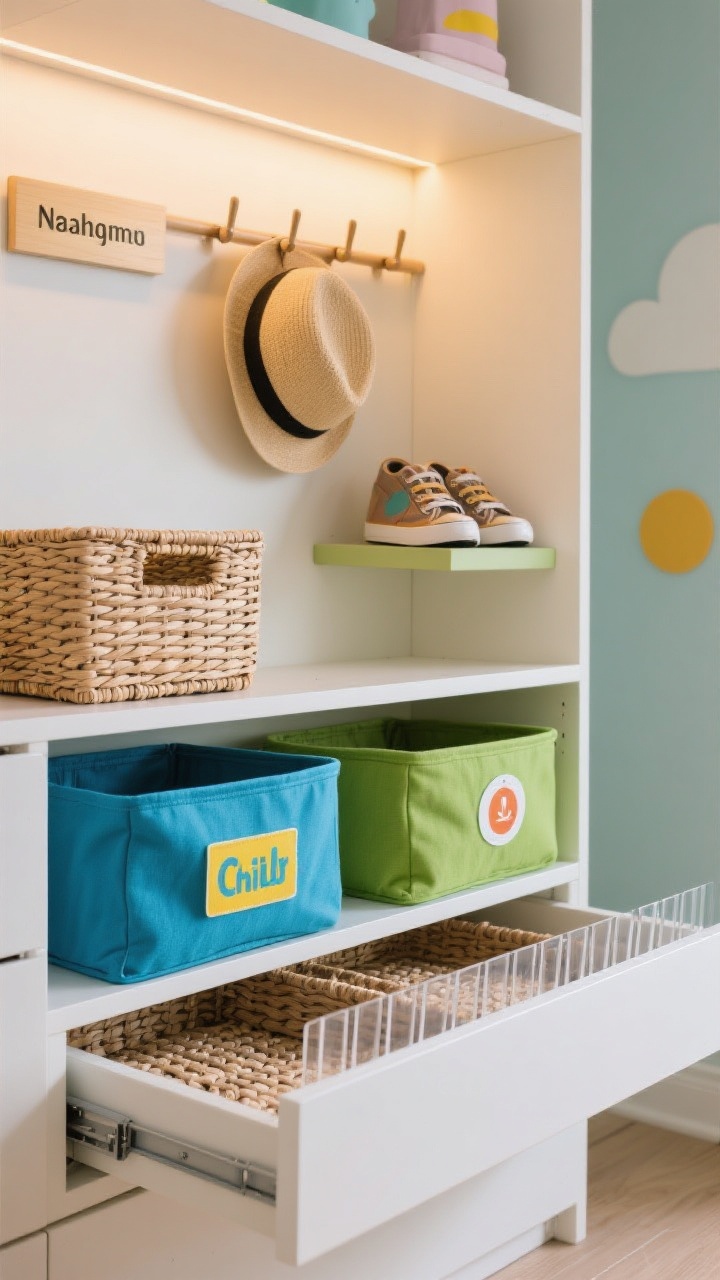
If it looks fun, they’ll actually put stuff away. Think of your storage like decor—because it is.
Design Details That Work Hard
- Color-code per kid: Blue bins for one, green for another. Or pick themes: stars, dinos, rainbows. Visuals beat nagging.
- Pretty, sturdy containers: Woven baskets, acrylic drawer dividers, fabric bins with handles. Label with bold fonts and icons.
- Open-top everything: Lids slow kids down. Bins, not boxes—quick toss, quick tidy.
- Display favorites: A peg rail for hats, a mini shelf for special shoes or hair bows. When they’re proud, they’re tidy.
Make it “their” space with a name plaque or a framed print. Ownership flips the switch from mess to “mine.”
Shopping Cheat Sheet
- Dividers and labels: Drawer insert sets, clip-on shelf dividers, vinyl or picture labels.
- Bins and baskets: Mix sizes—shoe box, half, and tall. Aim for uniform colors for a clean look.
- Hardware: Command hooks, over-door racks, double closet rod adapters.
The bottom line: Build systems your kid can use without you. Keep it low, label it loud, and rotate often. A few small tweaks, and your mornings will go from “Where are the socks?!” to “Wow, we’re early?” You’ve got this—and your drawers are about to look amazing.
